RIDDLE: What do Schultz's 1000 Places [worldwide] to See Before You Die, Villani's 100 Best Art Towns in America, the American Association of Retired Person's list of the 15 best retirement towns in the US, and Time's list of the 5 best repertoire theatres in America have in common?
ANSWER: Ashland, Oregon
EXPLANATION: Population 20,000 (6000 university students). Nine theatres and sixty art and antique galleries in a scenic valley with year-round outdoor recreational opportunities draw 500,000 tourists a year, 25 per resident compared with 4 per resident to London.
On Interstate 5, 350 miles north of San Francisco, 300 miles south of Portland, an anomaly among the dairy farms, fruit orchards, vineyards in and between the Cascade and Siskiyou mountains that forms the Rogue Valley. It began as a stage stop, became a timber, mining and railway town, and has taken on a New Age ethos. Weather is generally mild, although summer days can be hot. Precipitation averages 19″ per year almost entirely between December and February.
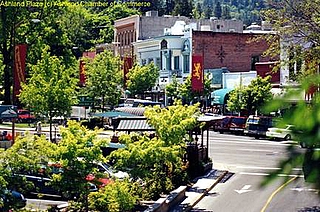 The downtown (all eight blocks) could serve as the set for Our Town. It centres on the block-on-a-side triangular Plaza and adjacent Lithia Park, which becomes more natural as one follows its creek into the mountains. Only one building is over three stories; it and 28 others are on the National Register of Historic Places. The town owns both a fibre optic network and a ski resort at nearby Mt. Ashland. A commission awards a bronze plaque to the “tree of the year.” There never will be a shopping mall in Ashland. McDonalds went broke.
The downtown (all eight blocks) could serve as the set for Our Town. It centres on the block-on-a-side triangular Plaza and adjacent Lithia Park, which becomes more natural as one follows its creek into the mountains. Only one building is over three stories; it and 28 others are on the National Register of Historic Places. The town owns both a fibre optic network and a ski resort at nearby Mt. Ashland. A commission awards a bronze plaque to the “tree of the year.” There never will be a shopping mall in Ashland. McDonalds went broke.
Not that you will starve. Do not limit yourself to the Plaza, East Main and North Main. There are 90-odd restaurants (an astounding one per 225 residents): usually two or more choices for most cuisines including Chinese, Deli, English, French, Indian, Italian, Japanese, Mexican, Middle Eastern, Seafood, Spanish, Thai, and Vegetarian as well as bakery, coffee, fast food, ice cream and sandwich shops and microbreweries, pubs and sports bars. Several have been featured in Gourmet Magazine.
You won't have to camp out (although you can). However, reservations are essential despite 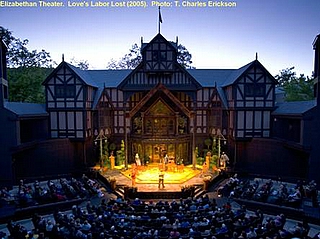 over sixty B&B's in turn-of-the-century Craftsman and Victorian homes that characterize the town and some twenty hotels and motels, including several in the downtown area.
over sixty B&B's in turn-of-the-century Craftsman and Victorian homes that characterize the town and some twenty hotels and motels, including several in the downtown area.
The Shakespeare Festival is the big draw. Each February through October 60-70 actors backed by 400 staff (50 costumers alone) offer about 775 performances of eleven plays in three theatres. The goal is “fresh and bold interpretations of classic and contemporary plays in repertory, shaped by the diversity of our American culture, using Shakespeare as our standard and inspiration.” It started in 1935 when Angus Bowmer, drama teacher at the then state normal school proposed using the town's abandoned Chautaqua to stage Merchant of  Venice and Twelfth Night. The town council stipulated boxing matches to cover the expected deficit, hoping Bowmer would not accept such an undignified linkage. Bowmer found the idea in keeping with the bawdiness of Elizabethan theatre and accepted. Ironically, the plays covered the deficit of the boxing. The Festival has continued ever since, with a few years off while Bowmer served in World War II. In 2007, the Festival will present As You Like It, On the Razzle (a variation on The Matchmaker aka Hello Dolly), The Cherry Orchard, Gem of the Ocean, and Tartuffe in the modernistic Bowmer. Three new American plays, Rabbit Hole, Tracy's Tiger, and Distracted will be in the intimate New Theatre. Romeo and Juliet, Taming of the Shrew, and Tempest will be in the half-timbered, outdoor Elizabethan.
Venice and Twelfth Night. The town council stipulated boxing matches to cover the expected deficit, hoping Bowmer would not accept such an undignified linkage. Bowmer found the idea in keeping with the bawdiness of Elizabethan theatre and accepted. Ironically, the plays covered the deficit of the boxing. The Festival has continued ever since, with a few years off while Bowmer served in World War II. In 2007, the Festival will present As You Like It, On the Razzle (a variation on The Matchmaker aka Hello Dolly), The Cherry Orchard, Gem of the Ocean, and Tartuffe in the modernistic Bowmer. Three new American plays, Rabbit Hole, Tracy's Tiger, and Distracted will be in the intimate New Theatre. Romeo and Juliet, Taming of the Shrew, and Tempest will be in the half-timbered, outdoor Elizabethan. 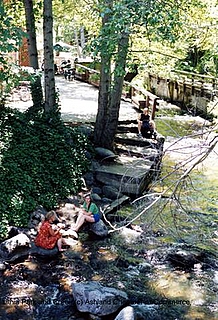
There are half-a-dozen other theatres in town, about a dozen live music venues, and a band shell in Lithia Park where events are frequent. The Brit Festival in nearby Jacksonville features internationally known blues, folk, jazz, popular, operatic and symphonic artists. The January Blues Festival, February Nature Film Festival, March Chocolate Festival, April Independent Film Festival, May Mountain Bike Festival, June “Feast of Will,” July Independence Day celebration, August book fair for local authors, September Flea Market, October Halloween Parade, November Festival of Lights, and December Dickens dinner and carolling reflect some of Ashland's many personalities.
Ski day or night, snowboard, ice skate, skateboard, bicycle, swim, play tennis, golf, or volleyball in season. Run with the Hash House Harriers. Joust with the Society for Creative Anachronism. Take in the Schneider Art and Science Works museums. Explore antique shops, art galleries, and boutiques. Indulge yourself at one of five spas. Spend a quiet hour or two in the town or university library. There are three book publishers and half a dozen booksellers-no chains of course.
Take a backstage tour. Bring a picnic to the free “Green Show” of music and dance just before summer evening plays. Come during the June Hot Air Balloon Festival in Grants Pass, or in September for the Pendleton Rodeo, and make a day trip to Crater Lake. Visit the town's two wineries-and others in the surrounding Rogue Valley Appellation. Artisanal foods, particularly cheeses, chocolates and fruits are popular gifts. Raft, kayak, or jet boat the Rogue River, itself divided into wild, scenic, and recreational sections. Fish, sail, or swim the local lakes. Hike part of the 4400-kilometre Pacific Crest Trail that runs along the southern edge of town north to Canada or south to Mexico.
Photo credits: Photos 1 and 4 courtesy of Ashland Chamber of Commerce. Photos 2 (T. Charles Erickson) and 3 (David Cooper) courtesy Oregon Shakespeare Festival.
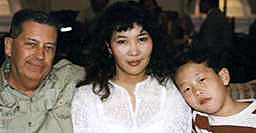 About the author: David is professor emeritus of Behavioural Science and of Humanities, California State University, and author of over 100 books and articles including Why We Fight: Theories of Human Aggression and Conflict (2005). He has been a Fulbright Scholar in Cyprus and Ukraine, a Malone Scholar in Bahrain and Saudi Arabia, worked in Australia, Singapore, and Morocco, and visited over 100 countries. He is co-founder and treasurer emeritus of Wildlife on Wheels, which provides live wild animal education programs to 100,000 Los Angeles basin children each year. He is married and has one child. Picture was taken of David and his family in the Raffles, Singapore (which is not the place it used to be, unfortunately.)
About the author: David is professor emeritus of Behavioural Science and of Humanities, California State University, and author of over 100 books and articles including Why We Fight: Theories of Human Aggression and Conflict (2005). He has been a Fulbright Scholar in Cyprus and Ukraine, a Malone Scholar in Bahrain and Saudi Arabia, worked in Australia, Singapore, and Morocco, and visited over 100 countries. He is co-founder and treasurer emeritus of Wildlife on Wheels, which provides live wild animal education programs to 100,000 Los Angeles basin children each year. He is married and has one child. Picture was taken of David and his family in the Raffles, Singapore (which is not the place it used to be, unfortunately.)
For more information, see: www.ashland.or.us or www.ashlandchamber.com, www.abbnet.com (B&B's), www.sorc.com (hotels and theatres). www.filmsite.org/afi100films.html (film festival), and www.osfashland.org (Shakespeare Festival). Information is readily available f rom a booth on the Plaza during the summer and all year from the local newspaper or the Chamber of Commerce is off the Plaza.

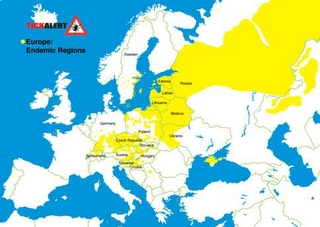 The warning identifies 16 central and eastern European countries where the TBE infected tick population is officially endemic and therefore poses a high risk to visitors who have not been immunised or taken bite prevention precautions.
The warning identifies 16 central and eastern European countries where the TBE infected tick population is officially endemic and therefore poses a high risk to visitors who have not been immunised or taken bite prevention precautions. 
 Mac has not been very well, but is still e-mailing strong. In this edition of the Globetrotter e-newsletter, Mac talks about a Japanese tea ceremony he attended whilst based in Japan shortly after WW2 and also the beginning of his five and a half year stint as a soldier in Japan in the 1950s.
Mac has not been very well, but is still e-mailing strong. In this edition of the Globetrotter e-newsletter, Mac talks about a Japanese tea ceremony he attended whilst based in Japan shortly after WW2 and also the beginning of his five and a half year stint as a soldier in Japan in the 1950s.